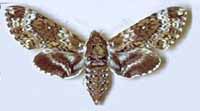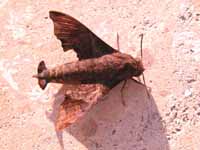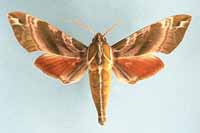Sphinginae subfamily
Sphingini tribe:
 |
Agrius cingulata
stray, The Pink-spotted Hawkmoth
This moth is a strong flier with strong migration tendencies and is
frequently encountered out of its more normal southerly range, although it may breed in South Carolina.
|
 |
If you have catalpa trees nearby, you are likely to encounter
this sphinx.
I saw them in great numbers in New Jersey. The larvae feed in large groups and are much more
spectacular than the moths.
Catalpa is the larval host. |
 |
This moth is not officially recorded in Clarendon, but it has been
observed to the north, west and south.
I even see this one on Prince Edward Island in eastern Canada.
It is named for the wavy lines on the forewings. |
 |
This moth is not officially recorded in Clarendon, but it has been taken to the north, west and south.
Larve are not limited to pawpaw.
|
 |
This species is widely distributed in South Carolina.
If you've got pines, this species is likely present. |
 |
Although ash is the popular larval foodplant, lilac and elm are also used. This species seems more common along
the coast from Connecticut to Florida. |
 |
This species is not officially recorded in Clarendon, but I suspect if you grow tomatoes you have encountered it.
Larvae get very large and can strip a tomato plant. |
 |
This species has forewings patterned much like Dolba hyloeus,
but Manduca rustica is much larger and more likely to be
spotted in Clarendon.
Moonflowers and petunias are favourite nectar sources.
|
 |
If you grow tomatoes you have probably encountered this species. They come readily to lights.
Larvae get very large and can strip a tomato plant. |

|
Although not officially reported in Clarendon County, I feel it is likely present.
It flies both to the north and south in South Carolina. It could easily be confused
with Ceratomia catalpae.
|
Smerinthini Tribe:
 |
This is the first Sphinx species I reared as a boy in New Jersey.
See the file for the female; she is different.
larvae feed upon Walnut and butternut (Juglans), hickory (Carya), alder (Alnus), beech (Fagus), hazelnut (Corylus),
and hop-hornbeam (Ostrya). |
 |
Named for the dull grey-blue spot in the hindwing, this moth has a
wide distribution and is
probably in Clarendon.
I regularly see them on Prince Edward Island, and they are reported
as far south as Florida. |
 |
Named for the small eye-spot in the hindwing, this moth has a wide distribution and is
probably common in Essex.
I regularly see them on Prince Edward Island, and they are reported as far south as Florida.
|
 |
This moth is widely distributed and fairly common so I suspect it is
in Clarendon, even though not recorded as such.
It has been recorded in nearby S.C. counties. |
Macroglossinae subfamily
Dilophonotini tribe:
 |
This moth is much more common in the deep south.
Larvae probably feed on Vitus tiliifolia and other members of the Vitaceae family: Vitis, Cissus, Ampelopsis.
|
 |
Hemaris thysbe RT, the Hummingbird Clearwing
This interesting day flier is confirmed for Essex.
They are widely distributed in the east from P.E.I. to Florida. |
 |
Hemaris diffinis RT, the Snowberry Clearwing or Bumblebee Moth
This moth is widely distributed and often reported north, west and
south of Clarendon.
I expect you have them. |
Philampelini tribe:
 |
This moth is not reported for Essex, but is fairly often reported
along the coast from southern New Jersey
to central Maine.
Note the differences between this moth and the Pandorus Sphinx. |
 |
Water Primrose and Evening Primrose are favourite adult nectar sources.
The larvae are brightly coloured and feed on these same plants. |
 |
If you have Grape or Virginia Creeper nearby, then you probably have this species.
I often get asked to identify larvae from areas where they have not previously been reported. |
Macroglossini tribe:
 |
This species is probably much more widely distributed than is
indicated. As a (rapid) day flier it would not be readily collected.
If you have Virginia Creeper, you
probably have the Nessus Sphinx. Two bright, distinct, narrow yellow bands are often visible on the
abdomen.
|
 |
You will often see this species listed as Darapsa pholus,
especially in older literature.
It is widespread in its distribution. I have reared them on Prince Edward Island
from locally caught females.
Pupae tend to be very lively. |
 |
Darapsa myron RT, the Virginia Creeper Sphinx or the Grapevine Sphinx
It is widely reported as far north as southern Maine. If you have the
foodplants indicated in the common names, you probably have this
species nearby. |
 |
If you have hydrangea growing near a stream, then you may have the
Hydrangea Sphinx. It has not been widely reported, however, and
probably is uncommon or not present.
|
 |
I do not know the origin of the species name choice, but "inscripta"
may have been chosen for the parallel "lines" on the forewings,
suggesting lines of script.
|
 |
Hyles lineata RT, the White-lined Sphinx
This species is widespread in the United States, and people regularly report finding larvae in their
gardens. The species also migrates, and sometimes there are population explosions. |
 |
This moth is very much under reported. It is a rapid day flier so is
probably not in too many collections. Grape is a popular larval host.
|
 |
I took one as a boy in New Jersey, but they aree much more common in the southern states.
Ryan Taylor reports seeing six to eight and has found a larva in Clarendon. |
|
|